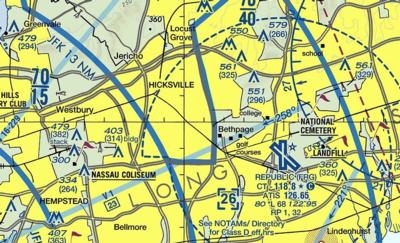Former Airport Site Had Industrial Buildings Rather Than A Landing Strip
Preliminary information released by the NTSB in an accident which occurred August 16, 2015 indicates that an air traffic controller directed a pilot having engine difficulty to an airstrip that had been closed and redeveloped into an industrial area. The pilot was fatally injured when the plane impacted a railroad grade crossing. A passenger on board the aircraft survived the accident.

According to the report, the Beech C35, N5946C, collided with a railroad grade crossing cantilever arm and terrain during a forced landing at Hicksville, New York. The commercial pilot was fatally injured and one passenger received serious injuries. The airplane was destroyed by impact forces and a post-crash fire. The airplane was registered to and operated by the pilot under the provisions of Title 14 Code of Federal Regulations Part 135 as an on demand air taxi flight. Day, visual meteorological conditions prevailed, and visual flight rules flight plan was filed. The flight originated from Westhampton Beach, New York (FOK) and was destined for Morristown, New Jersey (MMU).
According to preliminary air traffic control (ATC) voice communication and radar position information obtained from the Federal Aviation Administration (FAA), the airplane was flying at 6,500 feet above mean sea level on an easterly heading, about 8 nautical miles (nm) northwest of Republic Airport, Farmingdale, New York (FRG). The pilot reported to ATC that he was "having a little bit of a problem" and may need to return to FRG. The pilot then reported that he would have to "take it down…" The controller provided the relative locations of LaGuardia and JFK Airports, and stated that Westchester Airport was to the north and FRG was to the southeast. The pilot responded that FRG was the closest airport to his location. The pilot then indicated that he may not make FRG. The controller then provided information on "Bethpage strip" and informed the pilot that the airport was closed; however, there was a runway there. The airplane was then observed tracking toward the Bethpage area while descending.
The next several transmissions between the controller and pilot revealed that the pilot was unable to see the runway while the controller continued to provide heading and distance to the Bethpage runway. Radar and radio contact were eventually lost and emergency responders were notified of the accident.
The passenger was interviewed after the accident. He reported that the flight was in cruise when he heard a loud "pop" sound, with a flicker of light from the engine area, followed by an "oil smell." The engine then began to "sputter" and lose power. The pilot attempted to restart the engine without success.
The pilot, age 59, held a commercial pilot certificate with airplane single engine, multi-engine, and instrument airplane ratings. He reported 3,300 hours total flight time on his most recent application for an FAA second-class medical certificate, dated December 22, 2014. Records provided by the FAA revealed that he completed a Part 135.299 line check (check ride) on June 18, 2015.
The main wreckage was found inverted and burned, on the railroad tracks for the Long Island Rail Road. The wreckage debris field was about 100 ft in length and about 20 ft wide, oriented on a heading of about 150 degrees. All major structural components of the aircraft were found within the confines of the debris field. The propeller assembly separated from the engine during the accident sequence. The right wing was found under the grade crossing cantilever arm, which separated from its mount structure during the initial impact. The engine was retained for further examination.
An examination of the area of the former Bethpage Airport revealed that industrial buildings occupied the former runway surface area. The accident site was located about 0.25 nm northwest of the former runway's approach end.
(Pictured: Sectional chart of accident area)
 ANN's Daily Aero-Term (04.24.24): Runway Lead-in Light System
ANN's Daily Aero-Term (04.24.24): Runway Lead-in Light System ANN's Daily Aero-Linx (04.24.24)
ANN's Daily Aero-Linx (04.24.24) Aero-FAQ: Dave Juwel's Aviation Marketing Stories -- ITBOA BNITBOB
Aero-FAQ: Dave Juwel's Aviation Marketing Stories -- ITBOA BNITBOB Classic Aero-TV: Best Seat in The House -- 'Inside' The AeroShell Aerobatic Team
Classic Aero-TV: Best Seat in The House -- 'Inside' The AeroShell Aerobatic Team Airborne Affordable Flyers 04.18.24: CarbonCub UL, Fisher, Affordable Flyer Expo
Airborne Affordable Flyers 04.18.24: CarbonCub UL, Fisher, Affordable Flyer Expo



